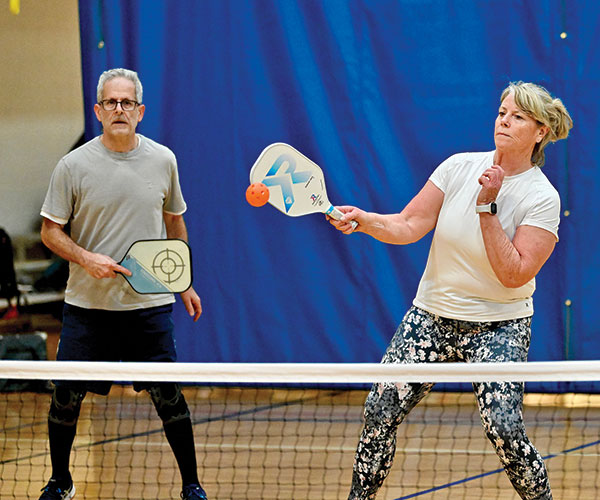Geared toward the 55-and-over market, today’s independent-living complexes appeal to individuals and couples interested in mobility and ample opportunities for socializing and recreation. While the boomer population is expected to live longer, healthier and more active lives than previous generations, medical experts say that along with increased longevity, many older adults will face the need for varying levels of care over their lifetime.
In the past, residents of independent-living communities would often have to relocate to off-site assisted-living and skilled-care facilities as their health needs changed. Nowadays, however, we’re seeing the development of communities that include a continuum of care for residents.
At Hamlet Village in Chagrin Falls, residents are offered a full range of care support, all situated on a 47-acre campus. The complex’s 12 buildings include condo-like independent-living apartments and single-family homes. “Most of our residents remain in independent-living housing for their entire lives,” says Marc Benson, president of Hamlet Village. “There’s a misconception that people must inevitably move to a nursing home. We do allow independent-living residents to bring in health-care services as necessary. And if they eventually need help with activities of daily living, they are welcome to move to one of the 80 apartments in our Atrium assisted-living facility.”
Hamlet also offers a skilled-care nursing facility, called The Manor, which serves long-term-care residents, as well as those with short-term needs, such as rehabilitation from a fractured hip. Benson, who has 25 years of experience in the active-adult-living industry, explains that his community’s mission is to enable adults to live as independently as possible, while embracing a “healthy aging” philosophy.
“The medical community tells us that one of the most important indicators of healthy aging is the level of an individual’s social network and the quality of social interaction they experience,” he says. “It’s a myth that people who have lived in their homes for 20 to 40 years should continue to live in that home. The problem with that model is that it leads to increasing social isolation.” A focus on health and wellness
While many active adults opt to move into independent-living communities to avoid such homeownership hassles as mowing the lawn and shoveling snow, many residents are also interested in living among people who share their age bracket and interests.
To promote social interaction among residents, active-adult communities often employ a full-time activities director who plans and coordinates social calendars filled with a variety of events, including walking clubs, gardening clubs, movie nights, concerts and dances. Fitness and recreation facilities are also key components of the active-adult-living experience. Organized fitness classes, ranging from water aerobics to tai chi, help participants maintain their physical health and mental well-being.
“One of our goals is to create an environment that helps our residents optimize their wellness,” says Jay Dettorre, president of the Western Reserve Masonic Community. Set on 220 acres in Medina, Western Reserve offers independent-living apartments, assisted-living units and a skilled-care facility. Catering to individuals who are 55 and older, Western Reserve is supported through the nonprofit Masonic organization, but is open to non-Masons.
“We encourage our residents to stay physically active,” Dettorre says, adding, “Along with a fitness center, we have a staff member who puts together fitness plans for our residents. One of her strengths is that she’s very sensitive to each resident’s capability.”
Western Reserve also offers a spectrum of activities, including a travel club, a theater group and arts programs. “As people progress through the phases of aging, we focus on their various wellness, emotional, spiritual and physical needs,” he explains. “Each step of our continuum of care addresses those specific needs.”
From an economic perspective, the cost of independent-living facilities is generally more expensive than traditional rental housing. “We like to say that you’re not just paying for bricks and mortar, you’re paying for a lifestyle,” says Benson. “And you’re also paying for the peace of mind that if you ever should need a higher level of care, it’s right here on campus. That’s important for both the residents and their children.”
Both Hamlet Village and the Western Reserve Masonic Community work to cultivate relationships among their residents and surrounding communities. Each year, Western Reserve hosts a two-day Renaissance Fair on its grounds. Open to the public, the event (which will be held October 4 and 5), features medieval costumes and family-friendly activities.
Benson says a key aspect of Hamlet Village’s mission is to promote its residents’ involvement in community events. “As an example, we help underwrite the costs of residents who want to enter their work in local art shows,” he says. “We also have many who volunteer their time to local nonprofit agencies such as Meals on Wheels. We even have a resident who delivers phone books to Amish schools.”
He adds that today’s active-adult communities are serving a generation that traditionally supported their community’s civic, philanthropic, cultural and religious organizations. “Volunteerism and civic duty has always been a vital part of our residents’ lives,” Benson says. “And we think it’s very important that we enable them to continue to embrace those activities.”



